Reader's Choice
Popular articles
Knitting socks with knitting needles is a very useful and exciting experience. For knitting socks, we need yarn, knitting needles, a little time and patience, especially if these are your first socks.
Ordinary socks can be knitted from one type of yarn, or from several, having made a work of art from ordinary knitted socks.
Before you start knitting socks, be sure to knit a pattern from the yarn that you have chosen for the product with the specified number of needles. For the width of the sample, we recruit 35-40 loops, knit 50 rows in height. Wet the finished sample and leave to dry. Dimensions related sample compare with those in the section "Density of knitting", if the density of your knitting coincides with that given, the socks will turn out the size you need.
For example, take a model for shoe size 38/39. The density of the model is: 30 loops x 42 rows = 10 cm x 10 cm. Small deviations from the given knitting density can be corrected by changing the number of the needles: if you knit more tightly than you need, take knitting needles more thickly, change the needles when you loose knitting on thinner.

To calculate the number of loops in the initial row, measure the girth of the leg over the bone. Cut out a strip of paper with a length equal to the girth of the leg, and along it, successively imposing on it a knitting pattern, determine the number of loops of the initial row. If the number of loops is not a multiple of 4, round the number up or down.
The number of loops of the initial row of our socks = 60. Having determined the number of loops of the initial row, we type them into 2 needles, then we remove one needle, we evenly distribute the loops into 4 needles = 15 loops each.
Technique knitting classic socks.
We collect on two spokes 60 loops. Then evenly distribute 15 loops to each knitting needle. Choose a gum, which will be connected sock cuff.
gum 1 x 1 (1st row - 1 face, 1 purl, 2nd row and all subsequent ones - face loops face, purl - purl)
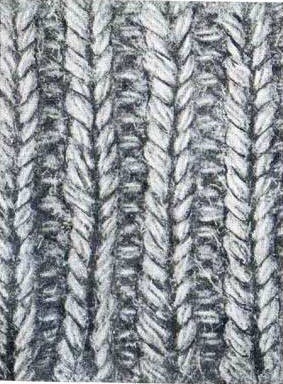
gum 2 x 2 (1st row - 2 facial, 2 purl, second and subsequent likewise, also note that we knit the facial loops with the facial, purl - purl).

The top of the sock fit in a circle. Having closed the distributed loops of the 1st row in a ring, further we knit a cuff with an elastic band. When moving from row to row, stretch the thread a little and tie the 1st loop tightly so that there is not a large hole in the gap between the loops of the adjacent needles.

The alternation of the front and back loops gives the cuff the necessary elasticity and elasticity. The upper part of the sock can be completely made into an elastic band, tied with a facial surface or other pattern at your discretion.
Having tied the upper part of the sock to the desired length, we leave half the loops (loops of the 2nd and 3rd knitting needles), continue knitting with only two knitting needles. We knit a rectangle - the heel wall, in rows in the forward and reverse directions on the loops of the 1st and 4th knitting needles, that is, we have 30 loops in our work. For the heel wall of our socks, let us bind 28 rows of facial surface.

After binding the required number of rows for the heel wall, we start knitting the lower part of the heel. To do this, divide the loops into 3 parts, 30 loops: 3 = 10 middle loops and 10 side loops each.
In the next front row, we knit with the front 10 side loops and 9 loops of the middle section.
We knit the 10th loop (last) of the middle part and the first loop of the side part of the face together, turning the work. We knit 9 loops with purl loops, the 10th last loop of the middle part and the first loop of the side part are knitted together with the purl. Again we turn the product, now we knit the front row again (do not forget to remove the 1st loop, as with ordinary knitting). We repeat these reductions until all side loops are used and only 10 middle loops remain in operation.

Now our task is to connect the heel with the foot. Again knit on all four needles face in a circle. To do this, we knit the heel of the lower part of the heel, then from each hem on the side edge of the heel wall we make 1 loop, then we knit the loops of the 2nd and 3rd knitting needles (= upper part of the foot) that have been set aside, then we recap the loop along the second side edge of the heel wall, we knit in a circle 3-4 rows in the usual way.

To give the sock a regular shape, it is necessary to reduce the loops to their initial number = before the start of the heel knit (in our example it is 60 loops).
We knit together the front, the last loop from the dialed side loops and the first loop from those that were not in work, that is, the loop of the upper part of the sock. After knitting further 29 loops, we again make reductions (30th loop of the upper part and 1 st loop from the side). These decrements will be repeated in each of the 3rd order until each of the 4 knitting needles again has 15 loops again, as before the start of the heel knitting.
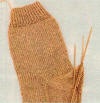
On a reduced number of loops to the original, we continue to knit in a circle until the beginning of the toe with a facial surface.
Having finished the straight part of the foot, proceed to the formation of the toe.

On the toe with side extensions, embossed paths are formed in the form of converging narrow ribbons: on the 1st and 2nd spokes there is an equal number of loops of one track, on the 3rd and 4th spokes of the second track loop are also distributed. To subtract from the 1st and 3rd knitting needles, do not finish knitting to the end of 3 points, the next 2 points to knit together the face and the last face. On the 2nd and 4th knitting needles of the 1st n. Knit up the front one, 2 of the next loops knit with a tilt to the left. Thus, in each row it decreases by 4 p. Subtracts are performed at a certain rhythm - in the 4th, every 3rd and 2nd p. and then in each row - until 8 p. remains on the needles. Pull these loops with a double thread, turn the sock out, pull the thread to the wrong side and firmly fasten it.
Wishes you inspiration and a lot of creative success!
If you understand how to knit socks with knitting needles by the traditional method, you will definitely want to create a more exquisite product, especially since the theme of knitting socks is endless. On this page linked from the heel - a very interesting model.
For inspiration, some beautiful socks from the Internet.
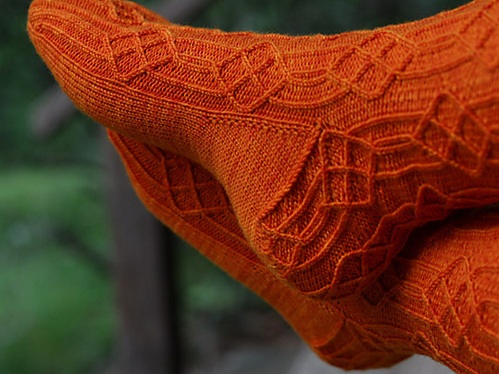
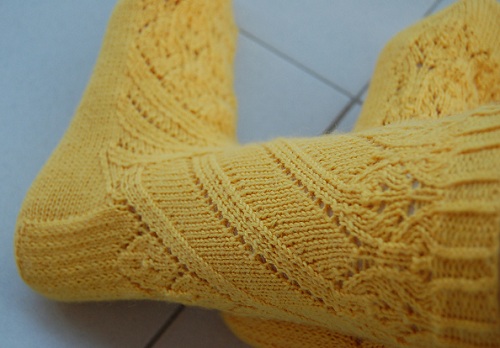

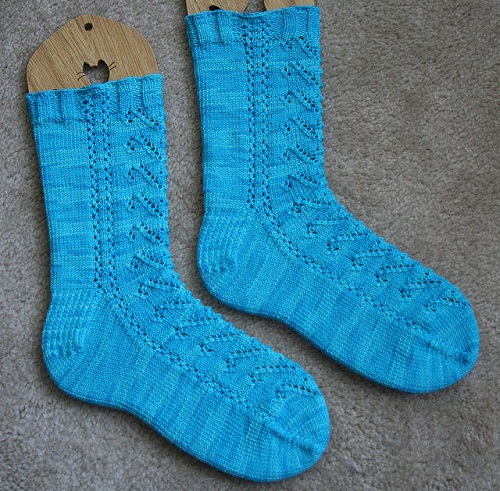


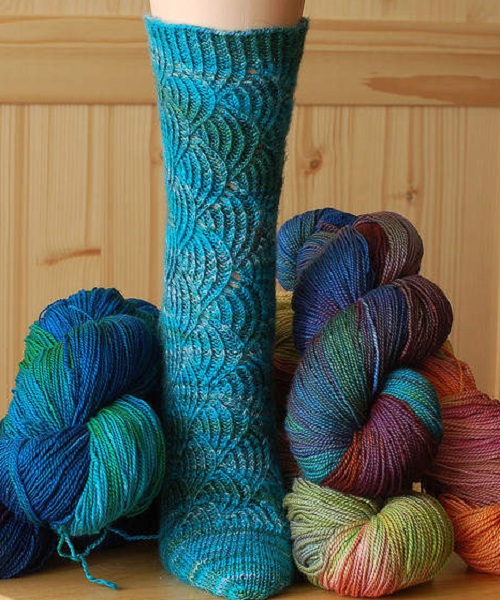
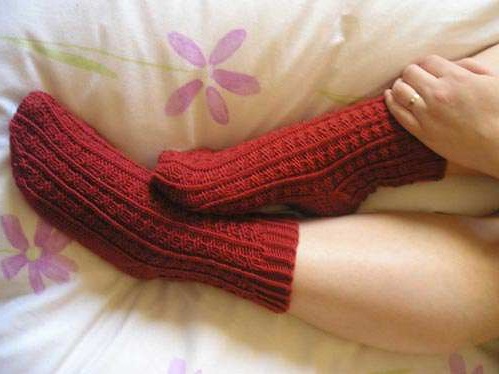

Beautiful knitted socks for beginners, knitting and crochet, and those who want to learn new techniques. Examples of knitting and crochet.
Knitted wool socks are not only warm, but also very beautiful. For those who do not leaf through magazines on needlework, knitted socks with their own hands are associated with ugly, though warm, grandmother's creations.
But today knitted socks are the same fashionable masterpiece of needlework, like a sweater, cardigan, fun.
But in order to socks were not only warm, but also pleased for a long time It is necessary to take into account some nuances.

Do you want beautiful socks? Do not save on yarn. In cheap threads there is neither the necessary composition of wool, nor bright standing colors. Pure wool for socks will not work, they will tingle, and they are torn down twice as fast. The optimal yarn options are 50-80% wool, the rest is acrylic.

Have you decided to knit fluffy socks? Angora is a great material, but only if you knit is not a child. Firstly, such socks will tingle; the feet will be itchy from them. Secondly, the kids are all pulling in the mouth for a sample, it is not necessary to give the opportunity to eat nap.
The choice depends on the thickness of the yarn. The main landmark is the inscription on the label of yarn. But we all knit in different ways - someone tight, someone swinging. Before you begin to knit a sock, knit a pattern. It should not be "knocked down", but holes should not show through (since the aesthetic appearance when worn will be spoiled).

Knitted items are recommended to be washed by hand, soaking in warm water. Do not wring in the machine and hands. It is better to squeeze the sock in the hands, while the main water will drain. Hang and wait for natural drying. Drying on batteries and heaters also shortens the life of the product.
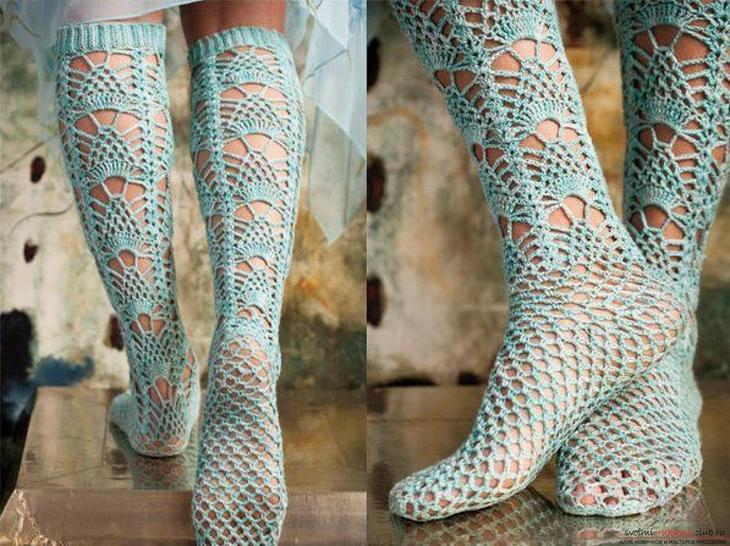
These socks traditionally knit on five needles. Yarn - wool mixture. The master class is only the basis, having mastered it, you can add all sorts of patterns, make narrow or wide strips and so on.
Knit a sample to calculate the loops of 10 loops on 10 rows. We take measurements as in the photo.

Now we define the average circumference in this way: we add a circle of lift and legs, divide by two. We have 31 and 21. Total 26 cm. Now we count how many centimeters in 10 loops in your sample, we determine the number of loops in 26 cm. Now divide by 4 (4 needles) and if the number is not divided, add a few loops to the multiplicity.
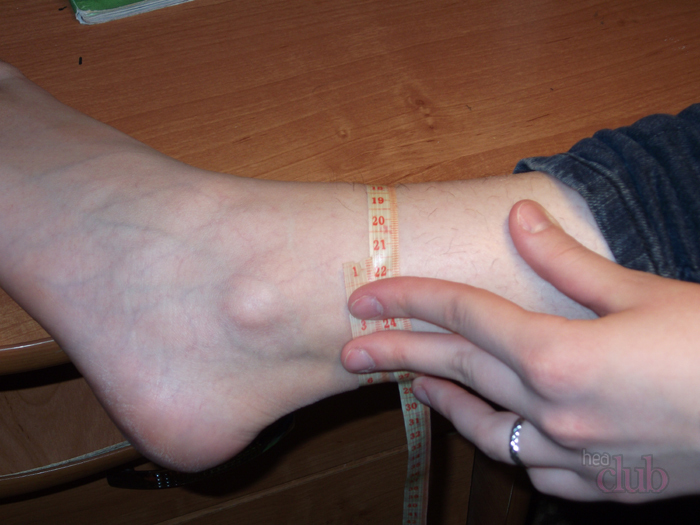
We collect loops on two spokes, distribute in the knitting of the first row into 4 needles.


We knit gum 1 * 1 or 2 * 2 5-6 cm, but is it possible to do less depending on the desire. Do you want the elastic to be elastic until the end of the sock? To the yarn, add a thread-gum in tone while knit gum.
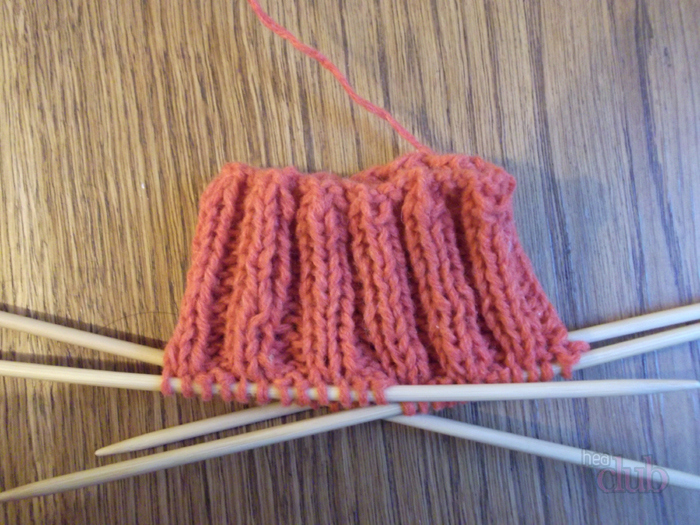
The next step is facial 7-9 cm.
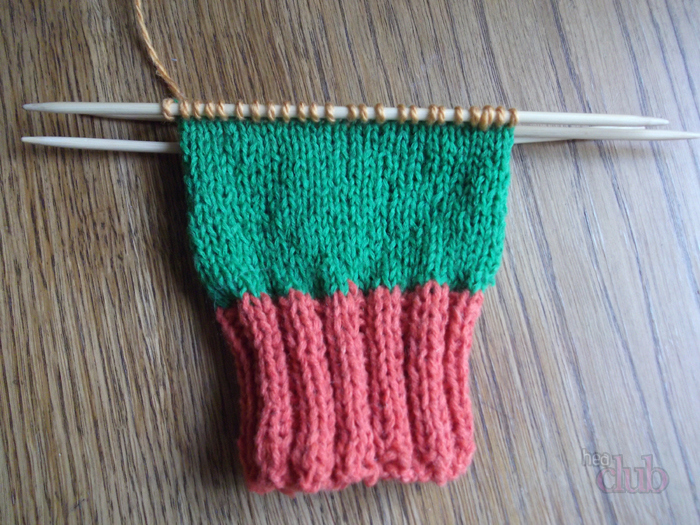
Now we connect the knitting of two knitting needles into one and knit 6 cm on them (height of the heel), depending on the lifting of the leg, it can be slightly increased.
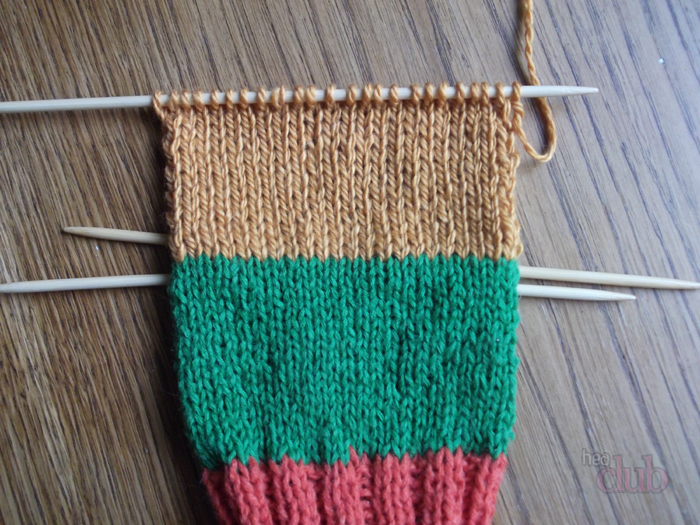
We divide loops into three parts, superfluous we refer to the middle part. We do the first row on the inside, so that the latter is on the face. We shorten it this way: we knit 1/3 of the knitting and knit the last loop of the first part with the first loop of the central part into one loop.
We knit the middle part and also cut the last loop of the middle part and the first third part.
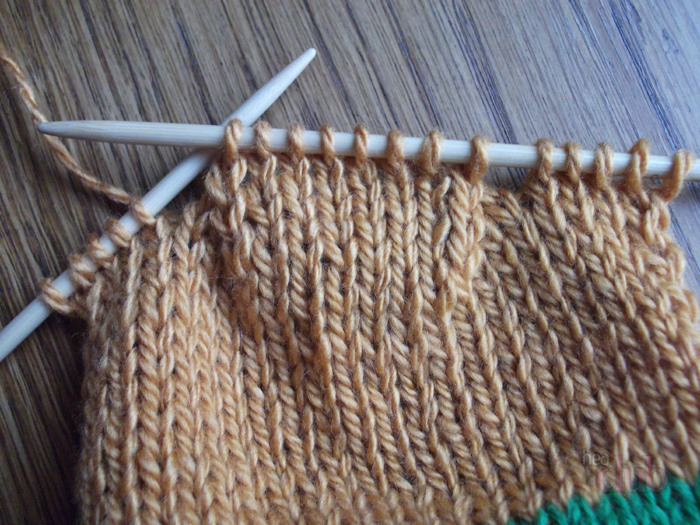
We turn over on the face, continue to cut, only the edges are reduced, the middle remains flat. We continue until all the loops are closed.
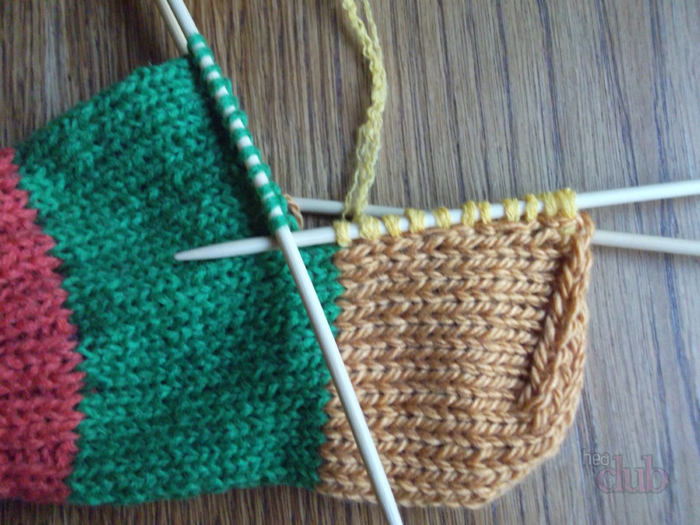
Now it’s best to take a hook. We raise the heels on the sides of the heels as in the photo. Again, divide everything into parts and knit the length to the little finger (depending on the size of your leg). What is convenient circular knitting sock - you can measure.
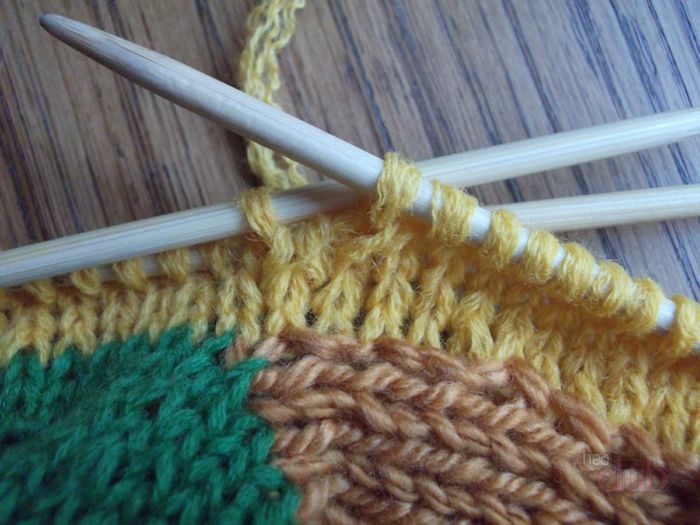
Now we start the reduction. The first needle: the first two loops together broach. The second needle: the last two loops together broach. The third needle: the first two loops together broach. The fourth needle: the last two loops together broach.
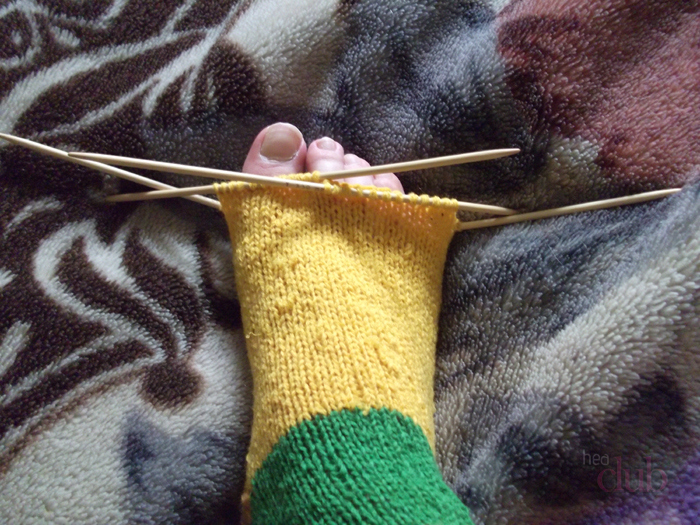
So knit until there are 2 loops on each needle. In order to get a "blunt" tip, close the 4 in 1 loop. If you want a “sharp” tip of the sock. 2 in 1, and then again 4 in 1.

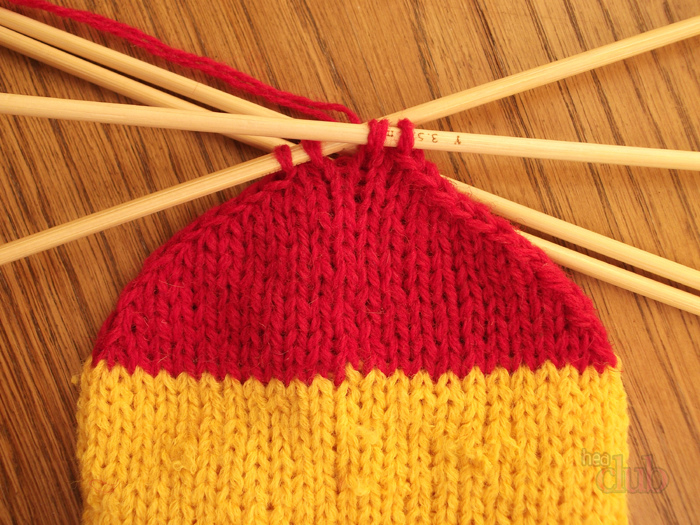
Tighten the thread and thread into the formed shovchik.

The previous master class is good because it tells the basics of knitting a sock on five needles, but for a masterpiece it is rustic. But these socks will become the pride of the needlewoman, and even the pickiest teenager will wear them with pleasure.
Yarn for these socks to choose not thick, wool.
One more interesting option Knitting socks openwork knitting, we could not miss. A feature of this model is that they can be knitted with cotton or bamboo yarn and worn in the warm season.
And this is the herringbone pattern. If there is a young girl at home who likes trendy things, ankle boots with socks are at the height of fashion today. These socks are what you need for a fashionable look!
One of the patchwork is a type of enterlac. The only exception to this fabric is not required thread breakage. We recommend to take a melange yarn of two colors with contrasting colors. Socks get unique!
To begin to master the technique.
And now go to the very socks.
And now to the most interesting! Yes, baby socks! They are bright, funny and very often cartoony! Do you want your baby's legs to look at everything in the garden? And mummies of other entryways filled up with orders? Then below are master classes especially for you.
Men of the color of the yarn, of course, you need to choose for a restraint, but this does not mean that you can not tie a masterpiece! We learn to knit beautiful socks that a husband or father will wear with pride.
There are a huge number of options for knitting women's socks. We will give only a small part of truly admirable, and even with detailed videos how to connect them!
This section will interest those who have already mastered the technique of knitting socks to perfection and are now looking for new solutions. Selection detailed videos with the best and at the same simple knitting for socks.
Ethno fashion for several years at the peak of fashion and is not going to go down from there. We offer you to join this trend and tie for yourself your favorite beautiful socks with an ornament.
And of course, for those who have mastered the technique, patterns, ornaments for such socks.
The word economy has firmly entered our lives, and with it the requirement for warm home clothes in the winter season. But this does not mean that now we should look less beautiful. Let's get used to a new lifestyle with chic! Knitted socks, boots, not only warm the hostess in the winter evenings, but also become a matter of pride.
But a few years ago there appeared fervent socks. Their popularity is amazing!
Mariana: the first time she took knitting needles because of the prices on the sites for knitwear. She decided on fashionable socks-ethno. So carried away that tied for the whole family. And now in the instagram this is our coolest photo! The whole family in the same beautiful socks :)
Inna: I’m knitting for a long time, but I don’t even have the desire to knit socks until my son came from the guests and demanded tank socks like a classmate. I started to look for a pattern and here the world of amazing socks opened up for me. We already have a collection for the exhibition. I can advise beginners to take bright and beautiful acrylic. The price is inexpensive, and worn, will be the same.
Hello dear blog readers!
I do not know about you, but I do not like to knit socks. A bit boring job, to be honest. And so I tried to create something to diversify this process, and to make the socks more interesting. It turned out this:
For knitting, she used pure wool woolen yarn “Pekhorka Derevnya”, hosiery needles No. 2.75. Socks were knitted on 48 loops, but if necessary, of course, the number of loops can be increased. The main thing is that the number of loops divided by 6, if you want to make a rubber band in the form of braids.
Dial 48 loops on the spokes and in the first row distribute them equally into 4 needles, 12 loops each. Close the row in a ring, and continue to knit in a circle with an elastic band with braids.
Eraser with braids (description for circular knitting):
1st - 4th rows: * 1 out., 4 persons., 1 out. * - repeat to the end of the row;
5th row: * 1 out., 4 loops to cross to the left (2 loops to remove and leave ahead of work, 2 following loops to knit with facial loops, then to knit the loops removed with facial loops), 1 to wear *;
6th - 10th rows: knit like the first 4 rows.
Then repeat, starting from the 5th row.
On my elastic band, the loops have been shifted 4 times, it seems to look harmonious. But someone may want a shorter gum, or longer - a matter of taste.
After the last, 4th offset loop, knit 3 more rows, like the first. Then we knit one row with facial, one row of purl, again one row with facial and in the next row we distribute loops for the pattern.
Knit pattern according to the above scheme. The diagram depicted , both in width and height. There are 2 rapport in the row. We start the series with the first loop of the circuit. It turns out that rapport is placed on 2 knitting needles (if knit with five knitting needles) - one rapport of the pattern will be placed in front of the sock, the other - in the back, above the heel.

*Note: If you need to increase the number of loops for knitting a sock, then you can simply make wider the tracks of rice knitting, or expand the central stripe with offset loops - knit it not on 10, but on 12, or 14 loops.
The scheme was created specifically for circular knitting, that is, since all the rows go over the face of the work - literally, as drawn on the scheme, and knit. And another little advice: when you need to cross the loops to the left, it is easier to re-shoot these loops before that, so that they lay on the needle as it is convenient to pick them up, to knit the second loop behind the first one.
![]()
Having knitted the required number of rapports in height (I have 5), we proceed to the heel. Here I have, because of the patterns, tying the heel a little bit different from the standard method in terms of proportions. Let me explain in more detail: usually when knitting a heel, the number of loops of a row is divided equally. One half remains on the needles, and on the loops of the other half, the heel is knitted.
I did not manage to split the loops evenly in half, as I wanted the strip of the pattern to go along the sides of the sock. Therefore, I did this: for knitting the heel, I identified a middle 18 loops of one rapport, and another 2 loops added along the edges for the hem ones, tying them out from between the adjacent loops. Total got 20 loops. They continue to knit two needles are no longer in a circle We knit as usual to get a chain-like edge. The remaining 30 loops are left just on the needles and until we knit.
The height of the heel knit depending on the height of the foot. We are trying on a sock on the leg to tie the heel to the desired height.
Then we divide 20 loops conditionally into 3 parts: 6 side loops, 8 middle loops, and 6 side loops. For convenience, the extreme loops of medium 8 loops can be marked by tying on them pieces of contrasting threads of color.
*Note: with a different number of loops, it can be divided either equally into 3 parts (if the number allows), or so that the middle is slightly larger, but the side parts must be the same.
Tying the heel “trough” begins with a purl row. We knit 6 extreme loops and 7 loops from the middle part. The last eighth loop of the middle part and the first loop of 6 loops of the side part are knitted together with a purl loop. The last 5 loops of the row are left on the left knitting needle and do not knit.
Turn knitting on the front side. The loop, formed from provyazyvaya 2 loops together in the previous row, remove neplyazannoy. Next, we knit the front 6 loops, the last loop of 8 medium loops and the first loop of 6 side knits together face loop for the rear walls.
Turn knitting on the wrong side. The loop formed from the loops knitted together is removed. Then we continue to knit the middle part of the heel, and again the last eighth loop from the middle part and the first loop from the side part are knitted together with the wrong side. Turn knitting, remove the loop, knit the middle part. Last loop we knit the front part of the middle part and the first loop of the side part.
Now we collect loops from a chain of edge loops of the connected part of the heel. Again we distribute all the loops to 4 needles, and knit already in a circle. In this case, it may turn out that after a set of loops from the edge loops, the total number will increase in comparison with the initial 48.

To return the number of loops to the original, do the following:
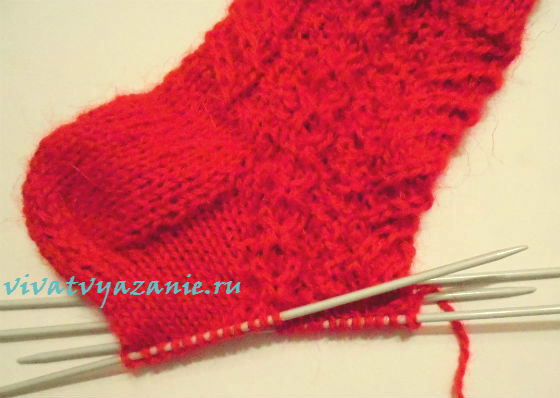
Now we calmly knit in a circle in the same spirit: the top is patterned, the bottom is knitted stocking. Periodically try on. When we knit so much so that the sock covers a small toe, we begin to reduce the toe.
You can completely knit stocking knit. But I wanted the side tracks to “run down” to the very end. Therefore, I knitted a toe stocking knitted with side tracks. And she diminished the loops for the toe, provyazyvaya on 2 together purl loops: purl loops from the side tracks and adjacent with them loops knitted hosiery, in all 4 places.

№ 5
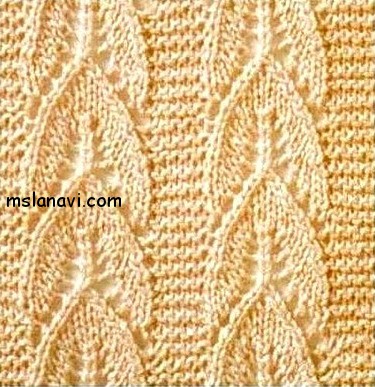
scheme
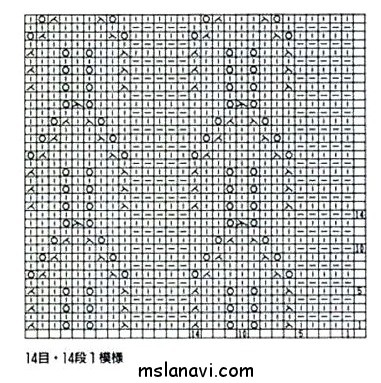
№ 6
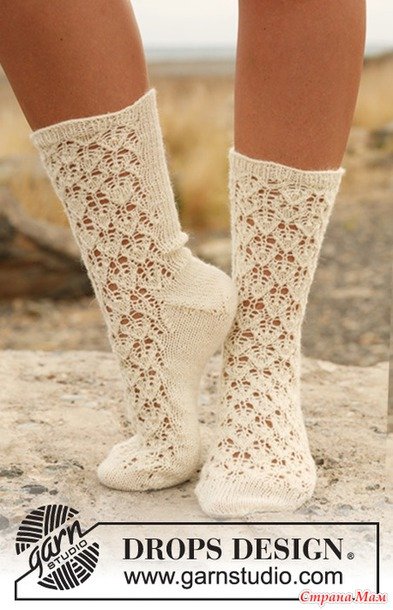
This model is perfect for a cool summer evening in nature. We knit openwork socks with 2.5 mm knitting needles from DROPS FABEL yarn with a composition of 75% wool / 25% polyamide with a thickness of 200m / 50g. Schemes for the execution of the openwork pattern are presented below.
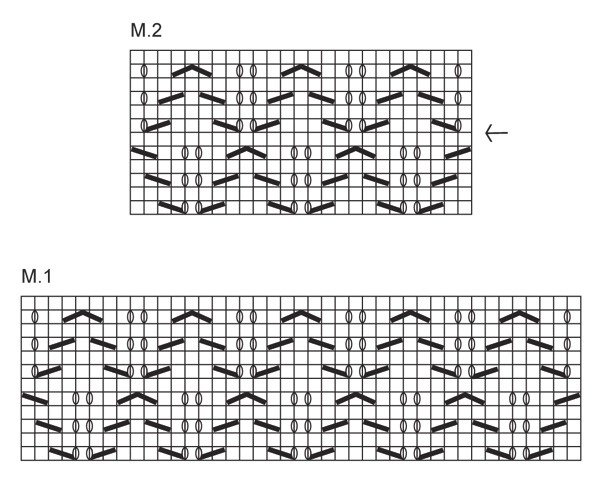
Conventions for schemes.
1 nakid:
2 together facial:
Remove 1 loop, knit a second face and stretch through the previous one:
Remove 1 loop, 2 together with the front one, stretch the resulting loop through the removed one:
For the 35-37th leg size, you need to draw 62 loops on the stocking needles and knit two rows with the front satin stitch, then complete 6 laps with an 1x1 elastic band. In the seventh row, to knit the first 11 loops also with an elastic band, and the remaining 51 loops - with the front satin stitch, while at the same time reducing 10 loops evenly. As a result, 52 loops remain. In the next row, the first 11 loops are knitted with a 1x1 rubber band, and the remaining 41 loops - with the pattern M1. When the length of the product becomes 16 cm, it is necessary to leave the elastic and 8 loops on each side, transferring the remaining loops to the pin - this will be the front part of the sock. The loops on the knitting needles are knitted with a facial surface another 5 cm up. In the center, place the marker and continue to measure from here. Knit the heel as follows:
First row (front): knit with facial until the last 7 loops, remove one loop, then one face, stretch it through the removed one and unfold it.
Second row (purl): knit purl to the last 7 loops, one we remove, then one purl, which we stretch through the removed one, we unfold.
The third row: we knit with facial ones up to the last 6 loops, we remove one, one with facial, stretch it through the removed one, unfold it.
Fourth row: knit purl to the last six loops, remove one, one purl, which we stretch through the removed, unfold.
So we knit until 15 loops remain on the needles. Then from each side we get 13 loops and return the loops from the pin, thus, on the spokes of 66 loops. We select the central 25 loops with a marker from two sides - this is the upper part of the foot. Then, the same 25 loops are knitted with the M2 pattern, and the remaining loops are knitted with the front satin stitch, while it is necessary to make a decrease on the sides as follows: 2 together with the front crossed to the marker and 2 together with the front after the pattern and 2 markers. Such reductions are done 8 times so that 50 loops remain. Execute the pattern to 18 cm from the center of the heel. Place the markers on the sides - 25 loops on top and 25 on the bottom and knit with the front satin stitch. It is necessary to make a subtraction to form a sock 2 loops before the marker as follows: 2 together with the front one, a marker, 2 together with the front one crossed. It is necessary to subtract through a row 4 times, then in each row 6 times. The remaining 10 loops pull and fasten.
We also offer two more tracery patternthat are perfect for beautiful socks:
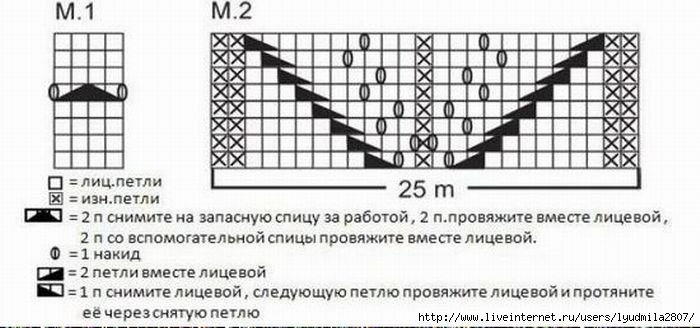
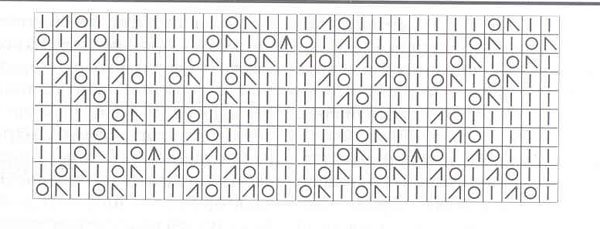
A little thought, you can take this pattern as a basis and develop your own model.
It is not necessary to give her husband a gift with his own hands for the holiday, sometimes he just needs care and attention, and at the same time warm things with which you can provide it. The simplest thing a needlewoman can do for her men is to knit their socks. Even a beginning knitter can handle this task. How to tie men's socks, you can learn without the help of video lessons.

For this we need:
For creating warm socks for men do not need a scheme, we give a simple description. During the explanation, we will use abbreviations:
Knitting begins with gum. We collect on two joint ventures 60 p. We distribute them on 4 joint ventures. We get the first p. 15 p. Close the circle. Knit with 1x1 rubber band (1 LP, 1 PI, wrong side according to the picture) 24 p. We turn to the front surface: in the face - LP, wrong side - FE. For men, it is not customary to knit patterns on their toes. Because just knit smooth 12 more p. So we get high socks that will warm the whole leg. If you need not so high products, it is worth tying no more than 4 -6 p.
Sock heel. For her, they often use a slightly darker yarn to make the socks look more interesting. There is no special scheme here either. We just collect the item from two joint ventures for one big one. On the rest we continue to knit another 10 p. Now you need to collect 30 points for one joint venture, then redistribute them to 3 joint ventures in this order: 1 SP - 9p, 2 SP - 12 pp, 3 SP - 9 p.
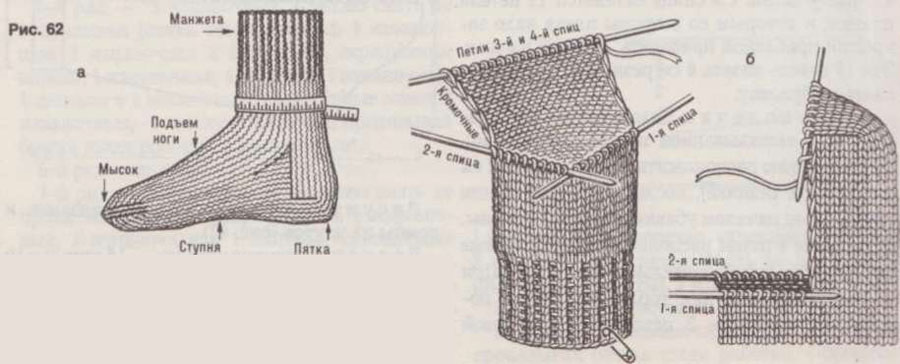
Next, we knit only the central part, on each side in each river, knitting with the last item, another item from the side SPs. So our loops from the side of the joint venture, will gradually be removed in the main knitting, forming an angle. Get a heel. If the process is difficult for beginning needlewomen, you can watch the video lesson, but the description is quite enough to do the job.
How to tie toe socks. We divide the bottom of the heel into two joint ventures; for them it is necessary to collect an additional number of loops on the side of the heel. So on each joint venture from the bottom it will turn out to be 18 p. We remove the upper pits from one SP into two, 15 p. We knit with the usual circle the front smooth surface. But first you need in the first, third and fifth p. remove the extra 3p. with lower spokes. In these p. knit on 2p. at the beginning of the top of the heel. Further, all according to the previous scheme, another 20 - 26 p., It depends on the size of the man's legs.
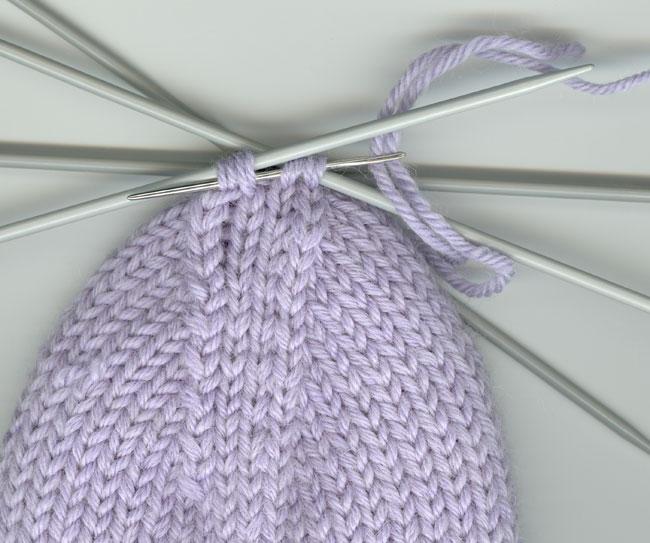
To knit a sock is simple. In every r. remove the side of 1 p. on each joint venture. It is better to take not the final loops, but the 2nd and 3rd paragraphs on each side of the joint venture. At the same time, we begin to clean gradually, through a series. On the fifth lap, you can start to remove the item in each p. . In the last tie the remaining 4 p. Together and tighten the thread.
Repeat the second sock in the same way. Knit men's socks knitting easily and quickly. It is more interesting to draw them in some pattern, stripes or small stars of a different color. If you own this technique, you can create a picture yourself; for new ideas you don’t need to watch the video; you only need to create a diagram yourself. For bands: every 2p. new color. For stars, it is better to choose a picture separately, and see how many times it will have to be repeated.
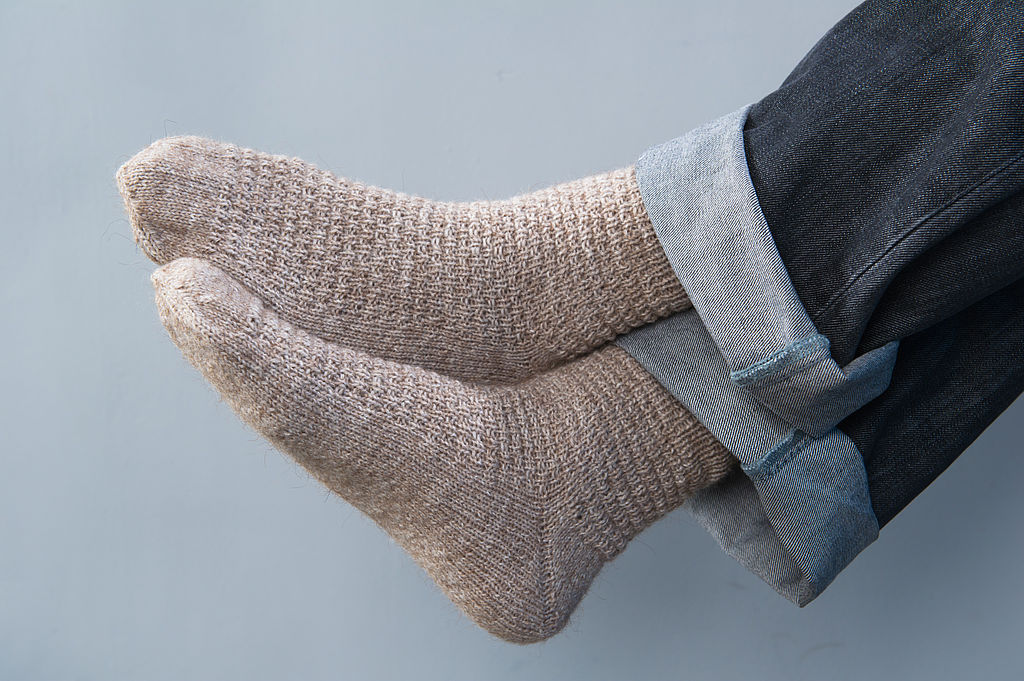
After the men's socks are knitted with knitting needles, it is better to immediately stretch, stretch and dry them. After they become softer, and it will be better to sit on the leg.
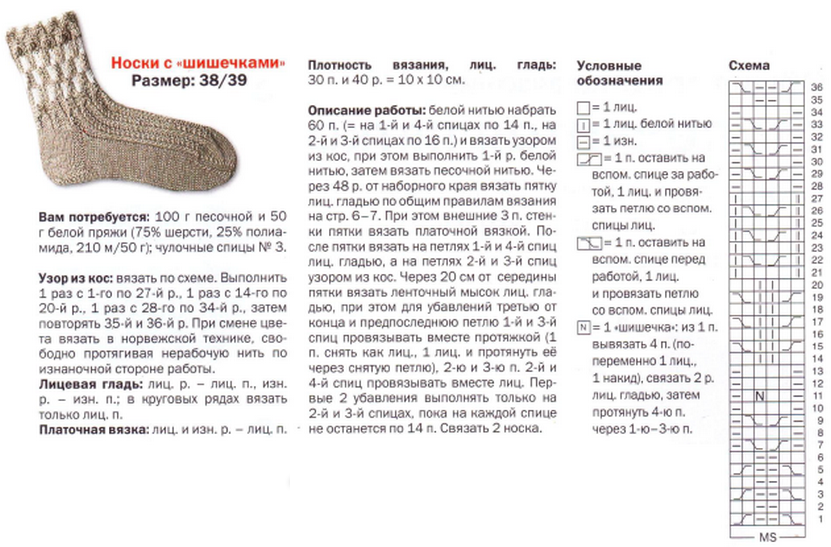
| Related articles: | |
|
Survival School. Tested on yourself. How to survive without money in a foreign city? How to live without money real examples
Stole money and documents. Well, it happens. Now we "do not ... Causes of kidney failure: effects and treatment
Symptoms of the development of the disease Chronic form of the disease Duration and ... Ulcers in the tongue: why arise and how to treat them?
Anyone is familiar with such an unpleasant phenomenon as ulcers, sometimes ... | |